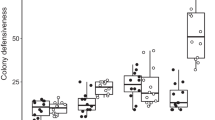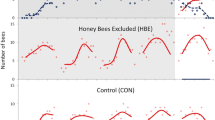Abstract
Foraging animals continually face the decision of whether to exploit known resources or explore for new ones, a decision with large implications for their fitness. Though animal foraging decisions have been extensively studied, we currently lack a deep understanding of how the exploitation-exploration trade-off has evolved, including how it is shaped by divergent selection pressures between species. As a first step towards examining how the exploitation-exploration trade-off has been adaptively tuned by natural selection, we compared the exploratory behavior of four honey bee species that differ in traits such as nest architecture, body size, and colony size. In a common behavioral context—exploratory behavior triggered by a decrease in quality of a known food resource—we found species differences in exploratory behavior that are consistent with selection arising from evolved differences in nest architecture, though the behavioral differences were also strongly influenced by the magnitude of the reward decrease. We had expected that species that build their nests in the open, and hence face a higher fitness cost of worker attrition compared with species that inhabit protective cavities, would be less likely to prolong unrewarded search when food declines in quality. The behavioral data were partially consistent with this expectation. However, at times, the environmental context strongly modulated species differences in behavior that would be expected based on nest architecture. Overall, our results suggest that the resolution of the exploitation-exploration trade-off has been adaptively tuned between species by a number of interacting selection pressures.
Significance statement
Foraging animals must constantly decide whether to exploit known resources or explore for new, potentially better, ones. How animals resolve this trade-off is likely to have a cumulative effect on their fitness, so natural selection should shape it according to species-specific differences in life history. Using an experimental approach comparing four honey bee species, our results suggest that the tendency to engage in costly search is shaped by multiple interactions among selection pressures differing between honey bee species. We found a correlation between search and how species build their nests, with species nesting in the open generally searching less than those nesting in cavities. However, past experience with a reward can sometimes interact with or overshadow the patterns expected based on nesting behavior. These patterns highlight the complicated effects of life history and ecology on the evolution of behavior.







Similar content being viewed by others
Data availability
The datasets generated during and/or analyzed during the current study are available in this published article and/or its supplementary information files.
References
Al Toufailia H, Grüter C, Ratnieks FL (2013) Persistence to unrewarding feeding locations by honeybee foragers (Apis mellifera): the effects of experience, resource profitability and season. Ethology 119:1096–1106
Berger-Tal O, Avgar T (2012) The glass is half-full: overestimating the quality of a novel environment is advantageous. PLoS One 7:e34578
Bhagavan H, Muthmann O, Brockmann A (2016) Structural and temporal dynamics of the bee curtain in the open-nesting honey bee species, Apis florea. Apidologie 47:749–758
Chole H, Woodard SH, Bloch G (2019) Body size variation in bees: regulation, mechanisms, and relationship to social organization. Curr Opin Insect Sci 35:77–87
Cook Z, Franks DW, Robinson EJ (2013) Exploration versus exploitation in polydomous ant colonies. J Theor Biol 323:49–56
Corbet SA, Unwin DM, Prŷs-Jones OE (1979) Humidity, nectar and insect visits to flowers, with special reference to Crataegus, Tilia and Echium. Ecol Entomol 4:9–22
Danner N, Molitor AM, Schiele S, Härtel S, Steffan-Dewenter I (2016) Season and landscape composition affect pollen foraging distances and habitat use of honey bees. Ecol Appl 26:1920–1929
Delaney JT, Jokela KJ, Debinski DM (2015) Seasonal succession of pollinator floral resources in four types of grasslands. Ecosphere 6:1–14
Dyer FC (1985) Nocturnal orientation by the Asian honey bee, Apis dorsata. Anim Behav 33:769–774
Dyer FC, Seeley TD (1987) Interspecific comparisons of endothermy in honey-bees (Apis): deviations from the expected size-related patterns. J Exp Biol 127:1–26
Dyer FC, Seeley TD (1991) Nesting behavior and the evolution of worker tempo in four honey bee species. Ecology 72:156–170
Eliassen S, Jørgensen C, Mangel M, Giske J (2007) Exploration or exploitation: life expectancy changes the value of learning in foraging strategies. Oikos 116:513–523
Flaherty CF (1982) Incentive contrast: a review of behavioral changes following shifts in reward. Anim Learn Behav 10:409–440
Fry CH (1983) Honeybee predation by bee-eaters, with economic considerations. Bee World 64:65–78
Harrison JF, Fewell JH (2002) Environmental and genetic influences on flight metabolic rate in the honey bee, Apis mellifera. Comp Biochem Phys A Mol Integr Physiol 133:323–333
Kapil RP (1959) Variation in the developmental period of the Indian bee. Indian BeeJ 21:3–6
Kastberger G, Sharma DK (2000) The predator-prey interaction between blue-bearded bee eaters (Nyctyornis athertoni Jardine and Selby 1830) and giant honeybees (Apis dorsata Fabricius 1798). Apidologie 31:727–736
Katz K, Naug D (2015) Energetic state regulates the exploration–exploitation trade-off in honeybees. Behav Ecol 26:1045–1050
Katz K, Naug D (2016) Dancers and followers in a honeybee colony differently prioritize individual and colony nutritional needs. Anim Behav 119:69–74
Kerr NZ, Crone EE, Williams NM (2019) Integrating vital rates explains optimal worker size for resource return by bumblebee workers. Funct Ecol 33:467–478
Kotler BP, Brown JS, Bouskila A (2004) Apprehension and time allocation in gerbils: the effects of predatory risk and energetic state. Ecology 85:917–922
Kramer DL, Weary DM (1991) Exploration versus exploitation: a field study of time allocation to environmental tracking by foraging chipmunks. Anim Behav 41:443–449
Lichtenberg EM, Heiling JM, Bronstein JL, Barker JL (2020) Noisy communities and signal detection: why do foragers visit rewardless flowers? Philos Trans R Soc B 375:20190486
Lima SL, Dill LM (1990) Behavioral decisions made under the risk of predation: a review and prospectus. Can J Zool 68:619–640
Lindauer M, Watkin B (1953) Division of labour in the honeybee colony. Bee World 34:63–73
Mardan M, Kevan PG (1989) Honeybees and ‘yellow rain’. Nature 341:191–191
McNamara J (1982) Optimal patch use in a stochastic environment. Theor Popul Biol 21:269–288
McNamara JM, Fawcett TW, Houston AI (2013) An adaptive response to uncertainty generates positive and negative contrast effects. Science 340:1084–1086
Mehlhorn K, Newell BR, Todd PM, Lee MD, Morgan K, Braithwaite VA, Hausmann D, Fiedler K, Gonzalez C (2015) Unpacking the exploration–exploitation tradeoff: a synthesis of human and animal literatures. Decision 2:191–215
Müller CB, Blackburn TM, Schmid-Hempel P (1996) Field evidence that host selection by conopid parasitoids is related to host body size. Insect Soc 43:227–233
Oldroyd BP, Wongsiri S (2009) Asian honey bees: biology, conservation, and human interactions. Harvard University Press, Cambridge
Page RE, Fondrk MK (1995) The effects of colony-level selection on the social organization of honey bee (Apis mellifera L.) colonies: colony-level components of pollen hoarding. Behav Ecol Sociobiol 36:135–144
Page RE, Robinson GE, Fondrk MK, Nasr ME (1995) Effects of worker genotypic diversity on honey bee colony development and behavior (Apis mellifera L.). Behav Ecol Sociobiol 36:387–396
Pankiw T (2003) Directional change in a suite of foraging behaviors in tropical and temperate evolved honey bees (Apis mellifera L.). Behav Ecol Sociobiol 54:458–464
Patrick SC, Pinaud D, Weimerskirch H (2017) Boldness predicts an individual’s position along an exploration–exploitation foraging trade-off. J Anim Ecol 86:1257–1268
Pecoraro NC, Timberlake WD, Tinsley M (1999) Incentive downshifts evoke search repertoires in rats. J Exp Psychol Anim Behav Process 25:153–167
Pyke GH (1984) Optimal foraging theory: a critical review. Annu Rev Ecol Evol Syst 15:523–575
Pyke G (2019) Optimal foraging theory: an introduction. In: Breed MD, Moore J (eds) Encyclopedia of animal behavior. Elsevier Academic Press, London, pp 111–117
Raffiudin R, Crozier RH (2007) Phylogenetic analysis of honey bee behavioral evolution. Mol Phylogenet Evol 43:543–552
Rana RS, Verma LR (1994) Hoarding behaviour and lifespan of workers of Apis mellifera and Apis cerana. J. Apic Res 33:205–208
Robinson GE (1992) Regulation of division of labor in insect societies. Annu Rev Entomol 37:637–665
Ruttner F (1988) Biogeography and taxonomy of honeybees. Springer, Berlin, Germany
Sandhu AS, Singh S (1960) The biology and brood rearing activities of the little honeybee (Apis florea Fabricius). Indian Bee J 22:27–35
Santhosh S, Basavarajappa S (2016) Study on nectar plants of few butterfly species at agriculture ecosystems of Chamarajanagar District, Karnataka, India. Inter J Entomol Res 1:40–48
Seeley TD (1983) Division of labor between scouts and recruits in honeybee foraging. Behav Ecol Sociobiol 12:253–259
Seeley TD (1985) Honeybee ecology: a study of adaptation in social life. Princeton University Press, Princeton
Seeley TD (1995) The wisdom of the hive. Harvard University Press, Cambridge
Seeley TD, Seeley RH, Akratanakul P (1982) Colony defense strategies of the honeybees in Thailand. Ecol Monogr 52:43–63
Singh KP, Kushwaha CP (2006) Diversity of flowering and fruiting phenology of trees in a tropical deciduous forest in India. Ann Bot 97:265–276
Stephens DW (1987) On economically tracking a variable environment. Theor Popul Biol 32:15–25
Stephens DW, Krebs JR (1986) Foraging theory. Princeton University Press, Princeton
Szabo TI, Heikel DT (1987) Patterns of honeybee colony gain in Alberta, Canada. Journal Apic Res 26:47–45
Tan NQ (2007) Biology of Apis dorsata in Vietnam. Apidologie 38:221–229
Townsend-Mehler JM, Dyer FC (2012) An integrated look at decision-making in bees as they abandon a depleted food source. Behav Ecol Sociobiol 66:275–286
Townsend-Mehler JM, Dyer FC, Maida K (2011) Deciding when to explore and when to persist: a comparison of honeybees and bumble bees in their response to downshifts in reward. Behav Ecol Sociobiol 65:305–312
Underwood BA (1991) Thermoregulation and energetic decision-making by the honeybees Apis cerana, Apis dorsata and Apis laboriosa. J Exp Biol 157:19–34
Visscher PK, Crailsheim K, Sherman G (1996) How do honey bees (Apis mellifera) fuel their water foraging flights? J Insect Physiol 42:1089–1094
Wajnberg E, Fauvergue X, Pons O (2000) Patch leaving decision rules and the marginal value theorem: an experimental analysis and a simulation model. Behav Ecol 11:577–586
Waldron FA, Wiegmann DD, Wiegmann DA (2005) Negative incentive contrast induces economic choice behavior by bumble bees. Int J Comp Psychol 18:4
Wei CA, Dyer FC (2009) Investing in learning: why do honeybees, Apis mellifera, vary the durations of learning flights? Anim Behav 77:1165–1177
Wiegmann DD, Smith BH (2009) Incentive relativity and the specificity of reward expectations in honey bees. Int J Comp Psychol 22:3
Winston ML (1991) The biology of the honey bee. Harvard University Press, Cambridge
Yogeswaran M, Ponnambalam SG (2012) Reinforcement learning: exploration–exploitation dilemma in multi-agent foraging task. Opsearch 49:223–236
Acknowledgments
We would like to thank Emily Mall and Julia Fudala for their help with data collection and the Michigan State University Center for Statistical Training and Consulting for assistance with statistical analyses. We would also like to thank two anonymous reviewers for constructive feedback on this manuscript.
Funding
This work was supported by a National Science Foundation Graduate Research Fellowship (DGE-1848739 to AY), a National Science Foundation Graduate Research Opportunities Worldwide Fellowship jointly funded by the National Science Foundation and the Science and Engineering Research Board, administered by the Indo-US Science and Technology Forum (DGE-1848739 to AY), and a Fulbright-Nehru Fellowship jointly funded by the US Department of State and the Republic of India (2018/ST/89 to AY). This work was also supported by the Michigan State University Department of Integrative Biology. Research in AB’s lab is supporteds by institutional funding from the National Centre for Biological Sciences (NCBS-TIFR; 12P4167) and the Department of Atomic Energy, Government of India, under 472 project no. 12-R&D-TFR-5.04-0800.
Author information
Authors and Affiliations
Contributions
Not applicable.
Corresponding author
Ethics declarations
Conflict of interest
The authors declare that they have no conflict of interest.
Ethics approval
Not applicable.
Consent to participate
Not applicable.
Consent for publication
Not applicable.
Code availability
The R code used to analyze data during the current study is available in this published article and/or its supplementary information files.
Additional information
Communicated by O. Rueppell
Publisher’s note
Springer Nature remains neutral with regard to jurisdictional claims in published maps and institutional affiliations.
Rights and permissions
About this article
Cite this article
Young, A.M., Brockmann, A. & Dyer, F.C. Adaptive tuning of the exploitation-exploration trade-off in four honey bee species. Behav Ecol Sociobiol 75, 20 (2021). https://doi.org/10.1007/s00265-020-02938-6
Received:
Revised:
Accepted:
Published:
DOI: https://doi.org/10.1007/s00265-020-02938-6




